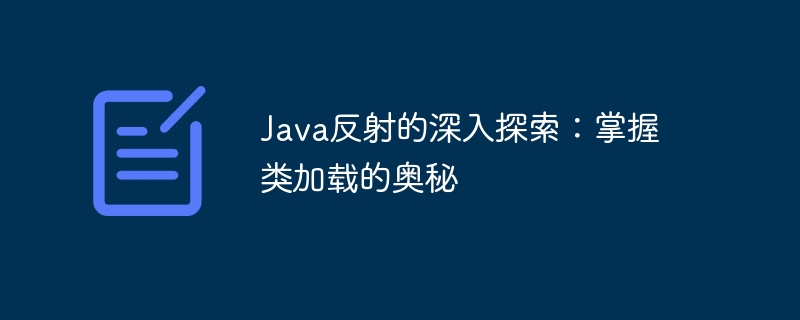Home >Java >javaTutorial >An in-depth exploration of Java reflection: mastering the secrets of class loading
An in-depth exploration of Java reflection: mastering the secrets of class loading
- 王林forward
- 2024-02-19 18:00:081336browse

php editor Strawberry will take you to explore Java reflection technology in depth and unlock the mystery of class loading. Java reflection is a powerful mechanism that allows programs to inspect and manipulate classes, methods, and properties at runtime. Through reflection, we can dynamically create objects, call methods, access properties, and even modify the structure of a class at runtime. Mastering Java reflection will add new possibilities to your programming skills, allowing you to better understand and utilize the class loading mechanism.
1. What is Java reflection?
Java Reflection, also known as Java reflection, is a powerful technology in the Java language that allows programs to inspect and modify class properties, methods, and constructors at runtime. In addition, Reflection allows programs to create new objects, call methods, and access fields at runtime.
2. Class loader: the unsung hero of JavaVirtual Machine
The class loader is responsible for loading class files into the Java virtual machine (JVM) so that they can be executed. Three built-in class loaders are created when the JVM starts: boot class loader, extension class loader and system class loader. The bootstrap class loader is responsible for loading Java core libraries, the extension class loader is responsible for loading extension libraries, and the system class loader is responsible for loading applications and their dependencies.
3. Learn more about how Java reflection works
Reflection apiCan be used through several classes in the java.lang.reflect package. These classes include Class, Field, Method and Constructor.
In the Reflection API, the Class class represents the class itself. You can use the getName() method to get the name of a class, the getFields() method to get the fields of a class, the getMethods() method to get all the methods of a class, and the newInstance() method to create an instance of a class.
In the Reflection API, the Field class represents a field of the class. You can use the getName() method to get the name of a field, the getType() method to get the field's type, the get() method to get the field's value, and the set() method to set the field's value.
4. Common uses of Java reflection
Java reflection has many common uses, including:
- Dynamic loading of classes: Using the Class.forName() method, we can load classes dynamically without knowing the name of the class at compile time. This is useful when creating pluggable components or extending existing applications.
- Dynamic proxy: Reflection can be used to create dynamic proxies. Dynamic proxies allow you to create proxies for objects at runtime and can intercept calls to object methods. This is useful when creating logging records, security, or performance monitoring agents.
- Custom bytecode generator: Reflection can be used to create a custom bytecode generator to generate custom classes. This is useful when creating compilers, interpreters or virtual machines.
5. Master the best practices of Java reflection
When using Java reflection, there are some best practices that need to be followed to ensure the robustness and performance of your code:
- Use reflection with caution: Reflection may cause performance degradation, so only use it when you really need it.
- Use reflection tools: There are many reflection tools that can help you use reflection more easily, such as asm-all, etc.
- Testing Reflected Code: Reflected code can be complex, so Testingreflected code is very important.
6. Conclusion
Mastering the Java reflection and class loading mechanism will help you take your Javaprogramming to the next level. By understanding how Java reflection works, you can not only solve problems, but you can also lay a solid foundation for improving the performance of your code and increasing the scalability and flexibility of your project. Now that you have understood the Java reflection and class loading mechanism, please apply it to your project to help your project succeed!
The above is the detailed content of An in-depth exploration of Java reflection: mastering the secrets of class loading. For more information, please follow other related articles on the PHP Chinese website!

